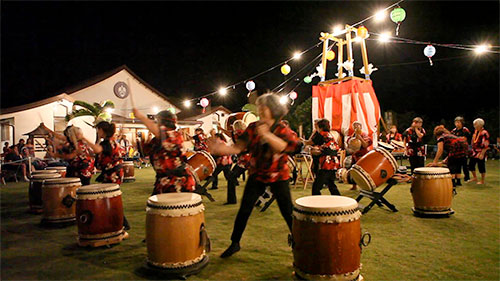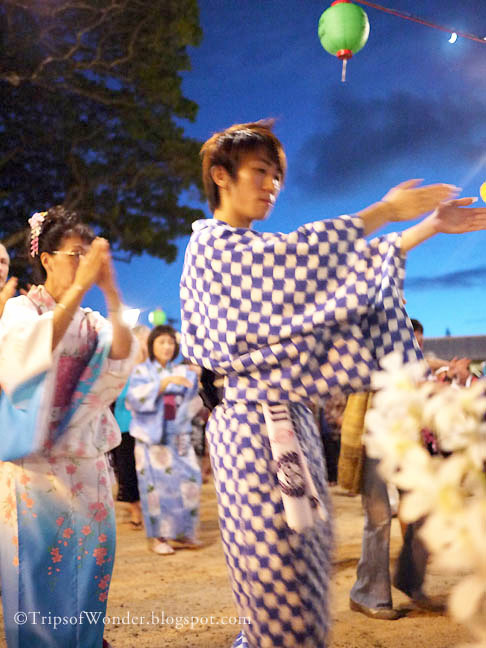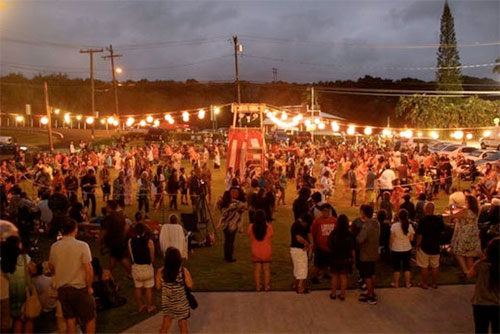
The sounds of music, taiko drumming and floating lanterns illuminating the sky can only mean one thing: Kauai bon dance season has begun. Just five minutes from Poipu, Koloa Town comes to life each year for the annual bon dance at Koloa Jodo Mission. Typically held from June through August, a bon dance is a traditional Buddhist ceremony to honor the spirit of one’s ancestors.
To experience a bon dance ceremony is to travel in time to the distant shores of Japan. Women and children dressed in elaborate kimono tied tightly with obi and men in Happi coats seem to float around the yagura, or a raised platform, in synchronized movements to the music. The deep emotion of this ceremony to honor the dead can be heard through its sometimes wistful, mournful or even happy musical melodies.

Photo Courtesy TripsofWonder.blogspot.com
Food booths serve a variety of local favorites, such as the sweet deep fried pronto pop (similar to a corn dog) or the flying saucer, a sandwich made of white bread, hamburger meat, and American cheese melted in a pie iron over high heat. The okinawan donut, called andagi, cooked fresh at the bon dance has a dense but sweet quality to it that melts in your mouth.
Children love going to bon dance for the games. Similar to a carnival, every bon dance offers a variety of game booths. The fish pond game is easily a favorite of all children. In this game, a bamboo fishing pole with a clothespin tied to the end of the line is thrown over a sheet wall to catch a fish. All children delight in catching a fun prize.
The history of the bon dance dates back to over 500 years ago in Japan. Buddhist transcripts tell a story of a devout monk who danced with joy when releasing the spirit of his mother from the realm of hungry ghosts. The tradition was first introduced to Hawai‘i in the early 19th century, when Japanese immigrants traveled from their homeland to the islands in search of a better life on the sugar and pineapple plantations. As these immigrants made Hawai‘i their home, their traditions and customs became a part of Hawai‘i’s melting pot culture.

Photo Courtesy Lihue Hongwanji
The bombing of Pearl Harbor in World War II nearly ended the celebration of obon season in Hawai‘i. Heightened attitudes and tensions towards Japan continued to be high and many Japanese living in Hawaii, including the Reverend at the Koloa Jodo Mission, were interned. The tradition of bon dance was resurrected through the effort of Japanese-American veteran groups, who revitalized and grew the ceremony into a event that all residents look forward to, whether of Japanese ancestry or not.
This year, the Koloa Jodo Mission will hold their annual bon dance on July 6 and 7, beginning at 7:30 p.m. and ending at 10:30 p.m.
The remaining 2018 bon dance schedule is as follows:
- June 8-9 Kapaa Jodo Mission
- June 15-16 West Kauai Hongwanji Mission (Hanapepe)
- June 22-23 Lihue Hongwanji Mission
- June 29-30 Waimea Shingon Mission
- July 6-7 Koloa Jodo Mission
- July 13-14 West Kauai Hongwanji Mission (Waimea)
- July 20-21 Kapaa Hongwanji Mission
- July 27-28 Waimea Higashi Hongwanji Mission
- Aug 3-4 Kauai Soto Zen Temple
When attending a bon dance, it’s important to remember to be patient. Each week’s bon dance is highly anticipated and draws a large crowd, meaning parking and long food booth lines can be a challenge. It’s best to get there early to eat and also find a nice seat to spectate. All are welcome to dance in the ring, whether you are dressed the part or not. Local courtesy is to wait until the prior song is finished before entering the ring and follow the movements of the person in front of you. Remember that this is a spiritual ceremony and it should be treated with the utmost respect.
The bon dance is a time honored tradition on Kauai, one that all can appreciate from young to old. It is an experience that will never be forgotten, and you may find yourself longing for a flying saucer long after your return home.
